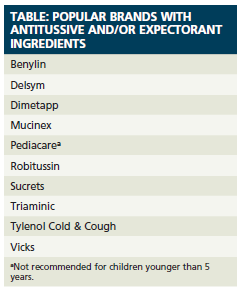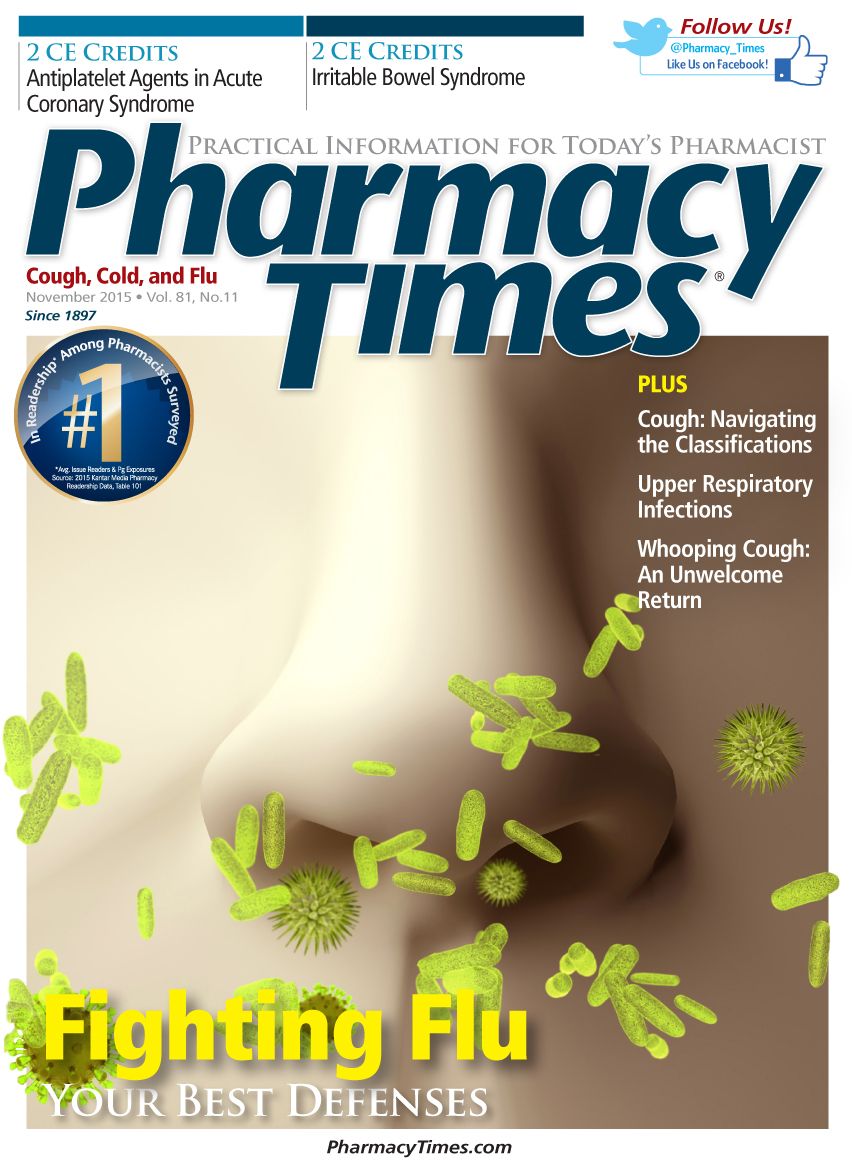
Publication
Article
Pharmacy Times
Cough: Navigating the Classifications
Author(s):
A cough is the body's natural reflex to help clear irritants from the throat and the airways of the lungs, but it can also be a symptom of a medical problem or an adverse effect of some medications.
A cough is the body’s natural reflex to help clear irritants from the throat and the airways of the lungs. It can also be a symptom of a medical problem or an adverse effect of some medications.1,2 Although an occasional cough is normal, a coughing attack can be very forceful. Prolonged coughing may cause chest pain, fractured ribs, exhaustion, dizziness and lightheadedness, loss of bladder control, and sleep interference.
Classification
Depending on duration, a cough can be classified as acute, subacute, or chronic. Acute coughs last less than 3 weeks and often result from a cold or other upper respiratory tract infection such as flu, pneumonia, or whooping cough. Subacute coughs, which last between 3 and 8 weeks, are frequently the residual cough after an illness or infection has resolved. Chronic coughs, which typically last longer than 8 weeks, can be caused by medical conditions and medications.1
A cough can further be classified as productive or nonproductive. The productive cough produces phlegm or mucus, which may have come from the lungs or the nasal sinuses. Some causes of a productive cough include viral illnesses, bacterial infection, postnasal drip, tobacco use, or the reflux of stomach acid. Nonproductive cough does not produce sputum. This may be the result of the residual effects of a viral illness or bacterial infection, bronchospasm, allergies, medications, exposure to irritants, asthma, or airway blockage.3
Children are prone to develop cough from causes specific to their age group, including croup, bronchiolitis, respiratory syncytial virus, secondhand smoke, and emotional or psychological problems (psychogenic cough).4
Diagnosis
The key to successful management of cough is to establish a definitive diagnosis and treat the cause of the cough. Misdiagnosis is common because many clinicians fail to recognize that cough is often the result of issues outside of the airway, such as rhinitis or gastroesophageal reflux disease (GERD).5
A physician will diagnose the cause of cough based on medical history, physical exam results, and test results. During the medical history, the physician will ascertain current medications, asthma and allergy history, history of heartburn or sour taste in the mouth, recent illness, and environmental factors such as smoke exposure (primary or secondary), air pollution, dust, or fumes. The physical exam will consist of palpations and stethoscopic airway inspection.6
Based on the medical history and physical findings, the physician may order additional tests including a mucosal culture, a pH probe, a chest or sinus x-ray, or a lung function test. A mucosal culture is taken from the nose or throat and can identify a bacterial infection. A pH probe may be used if the clinician suspects GERD. A chest x-ray can help diagnose conditions such as pneumonia and lung cancer, and a sinus x-ray can help diagnose a sinus infection. Lung function tests can help diagnose asthma and other lung conditions by measuring how much and how fast a patient can breathe in and out and how well the lungs deliver oxygen to the blood.6
Medication-Induced Cough
Several medications can induce cough, the most notable being the antihypertensive class of drugs called angiotensin-converting enzyme (ACE) inhibitors. ACE inhibitors cause a cough in 5% to 35% of patients. This dry, persistent cough can occur within hours of the initial dose or can be delayed for weeks or months. The exact mechanism by which ACE inhibitors induce this cough is not thoroughly understood, but is thought to be due to accumulation of the protussive mediators bradykinin and substance P that are normally degraded by ACE inhibitors.7
Another drug that may cause cough is the selective dipeptidylpeptidase-4 (DPP-4) inhibitor sitagliptin (Januvia), indicated for the treatment of type 2 diabetes. Approximately 5% to 6% of patients receiving sitagliptin develop upper respiratory tract infections, cough, and sore throat. Symptoms usually develop within 8 weeks of the initial dose. DPP-4 can cleave substrate P and other airway peptides. Sitagliptin inhibits this activity, thereby causing accumulation of these peptides.8
Inhaled corticosteroids may also induce a dry cough due to local deposition in the oropharynx or larynx. This can be avoided by rinsing the mouth and gargling with water after using these inhalation products.
The Pharmacist’s Role

A cough can be the result of a simple cold or an indication of something as serious as lung cancer. Pharmacists should advise their patients to seek immediate medical attention if a cough is accompanied by choking, difficulty breathing or swallowing, or bloody or pink-tinged phlegm. The patient should also be encouraged to see a physician if the cough does not go away after several weeks. A physician visit is also in order if the patient is a child and the cough is accompanied by thick phlegm, wheezing, a fever of more than 100°F, or shortness of breath.2
Pharmacists can provide recommendations for expectorants, antitussives, and home remedies to help patients manage a bothersome cough. Home remedies include lifestyle changes such as smoking cessation and irritant avoidance. Hydration, the use of humidifiers, and dissolving cough or throat drops to soothe the throat may also help.
The only available FDA-approved expectorant indicated for the symptomatic relief of acute, nonproductive cough is guaifenesin, which is available in many dosage forms. Available OTC antitussives include dextromethorphan, diphenhydramine, and codeine (in most states). The Table lists some popular brands containing products with good antitussive and/or expectorant ingredients.
Before recommending any OTC remedies, pharmacists should screen patient medical, medication, and allergy histories to verify the recommended medication will not cause a drug interaction or contraindication. For pediatric patients, pharmacists should only recommend products that have been specifically manufactured for pediatric patients. Patients and caregivers should be reminded to read all labels and follow instructions exactly to ensure accurate dosing.
Dr. Kenny earned her doctoral degree from the University of Colorado Health Sciences Center. She has 20-plus years’ experience as a community pharmacist and works as a clinical medical writer based out of Colorado Springs, Colorado. Dr. Kenny is also the Colorado education director for the Rocky Mountain Chapter of the American Medical Writer’s Association.
References
- Cough. National Heart, Lung, and Blood Institute website. http://www.nhlbi.nih.gov/book/export/html/4970. Accessed September 3, 2015.
- Cough. Mayo Clinic website. http://wee.mayoclinic.org/symptoms/cough/basics/definition/sym-20050846?p=1. Accessed September 3, 2015.
- Cold, Flu, & Cough Health Center: Coughs, Age 12 and Older- Topic Overview. WebMD website. http://www.webmd.com/cold-and-flu/tc/coughs-topic-overview. Accessed September 3, 2015.
- Cold, Flu, & Cough Health Center: Coughs, Age 11 and Younger- Topic Overview. WebMD website. http://www.webmd.com/children/tc/coughs-age-11-and-younger-topic-overview. Accessed September 3, 2015.
- Morice AH, Fontana GA, Sovijarvi M, et al. The diagnosis and management of chronic cough. Eur Respir J. 2004;24:481-482.
- How Is the Cause of Cough Diagnosed? National Heart, Lung, and Blood Institute website. http://www.nhlbi.nih.gov/health/health-topics/topics/cough/diagnosis. Accessed September 3, 2015.
- Dicplinigaitis PV. Angiotensin-Converting Enzyme Inhibitor-Induced Cough: ACCP Evidence-Based Clinical Practice Guidelines. Chest. 2006;129(1):169S-173S.
- Baraniuk JN, Jamieson MJ. Rhinorrhea, cough and fatigue in patients taking sitagliptin. Allergy Asthma Clin Immunol. 2010;6(1):8.

2 Commerce Drive
Cranbury, NJ 08512
All rights reserved.





